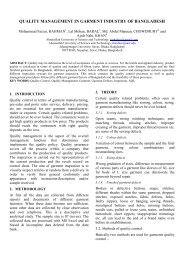SUSTAINABLE DEVELOPMENT MODELING (VANU-OPREAN-BUCUR MODEL)
SUSTAINABLE DEVELOPMENT MODELING (VANU-OPREAN ...
SUSTAINABLE DEVELOPMENT MODELING (VANU-OPREAN ...
Create successful ePaper yourself
Turn your PDF publications into a flip-book with our unique Google optimized e-Paper software.
The process of mathematical transformation of the<br />
social component requires the solving of two<br />
additional problems and simultaneously different:<br />
identification of correlation dependencies, for<br />
building up multifactorial models and researching<br />
the optimal criteria of employee activity in an<br />
industrial organization.<br />
Mention should also be made that the study of social<br />
indicators by means of mathematical models is<br />
currently confronted with some obstacles that might<br />
be accounted by: insufficient development of<br />
sociological research, limited scale, restricted<br />
problematics; poor theoretical perspectives of many<br />
sociological problems; lack of necessary<br />
coordination of the efforts of sociologists,<br />
economists, demographers, psychologists,<br />
mathematicians, cyberneticians, logicians etc; poor<br />
knowledge by sociologists of the mathematical<br />
apparatus; low level of development in the<br />
mathematical fields of the specific “social” fields of<br />
application; insufficient knowledge of the calculus<br />
technique specially adapted to solving sociological<br />
research problems.<br />
2. HYPOTHESES AND ORIGINAL<br />
METHODOLOGY<br />
Hypotheses<br />
Such a model has the following components:<br />
• the objective function, purpose function, DDOI<br />
function;<br />
• variables (indicators, parameters) and their<br />
influence factors;<br />
• limitations applied to variables.<br />
The function of sustainable development in<br />
industrial organizations may be related to the<br />
following aspects:<br />
• it represents a global indicator of sustainable<br />
development in industrial organizations, dependent<br />
on partial indicators (parameters);<br />
• it provides a method for the assessment of<br />
sustainable development in industrial organizations,<br />
for an estimation of their chronological evolution, or<br />
optimal accomplishment;<br />
• the possibility of making various predictions,<br />
forecasts regarding sustainable development, on the<br />
basis of its values;<br />
• performing comparative approaches to the<br />
functions of sustainable development of several<br />
organizations, and the conclusions refer not only to<br />
their „increase” but also to a „sensible” (in terms of<br />
ethics, morality) increase of sustainable<br />
development;<br />
• it provides a mathematical solution to various<br />
optimization problems – at the economic, social,<br />
environment levels - of the purpose functions, that<br />
might occur in the expression of the DDOI function<br />
by employing operational research methods. The<br />
methods specific to mathematical analysis,<br />
differential calculus cannot be applied, since the<br />
definition fields do not meet the necessary<br />
requirements (structure). Differential calculus may<br />
be used for the study of indicator optimization, as<br />
these indicators may be considered both as time<br />
functions and interdependent by functional relations.<br />
• fDDOI analysis may be approached by means of<br />
numerical methods referring to calculating certain<br />
functions by drawing up discreet value tables.<br />
Knowing the values of an f function at some points<br />
of the definition interval, called interpolary nodes,<br />
any other function sharing similar values with f in<br />
these nodes, will be an interpolary function for f. For<br />
instance, in the case of linear interpolation, the f<br />
graph is represented as a polygonal line where the<br />
end/top is (xi, f(xi)). Other interpolary functions:<br />
Lagrange, Legendre, Hermite, Cebîșev polinoms.<br />
• there is a minimum-maximum mathematical<br />
model, where production , represents the<br />
maximum function, and the secondary effects<br />
entailed by technological activities<br />
, … , , , , , . <br />
represent the minimum functions;<br />
• the mathematical model is applicable to<br />
optimization criteria (criteria used for profit<br />
maximization, maximization of renewable resources<br />
consumption, minimization of production costs and<br />
energy costs) or it can be approached by means of<br />
multifactorial optimization (also called Pareto<br />
optimization). The general expression of the model<br />
(problem) for linear programming is [4]:<br />
<br />
∑<br />
<br />
<br />
∑<br />
≤ ≥ , = 1, <br />
<br />
, (1)<br />
≥ 0, = 1, <br />
• Operational research methods may be:<br />
deterministic (linear programming, critical way),<br />
probabilistic (waiting threads, Pert) and simulative<br />
(Monte Carlo, dynamic simulation).<br />
The orientation of sustainable development analysis<br />
towards optimal solutions to problems is also<br />
facilitated by marginal calculus thus enabling the<br />
identification of maximum or minimum<br />
circumstances.<br />
The essence of marginal calculus and its usefulness<br />
in the analysis start from the functional relations (9),<br />
(10), that is: = , = , = , =<br />
, = .<br />
It is well known that the graphic representation of<br />
any function may be accomplished by means of






